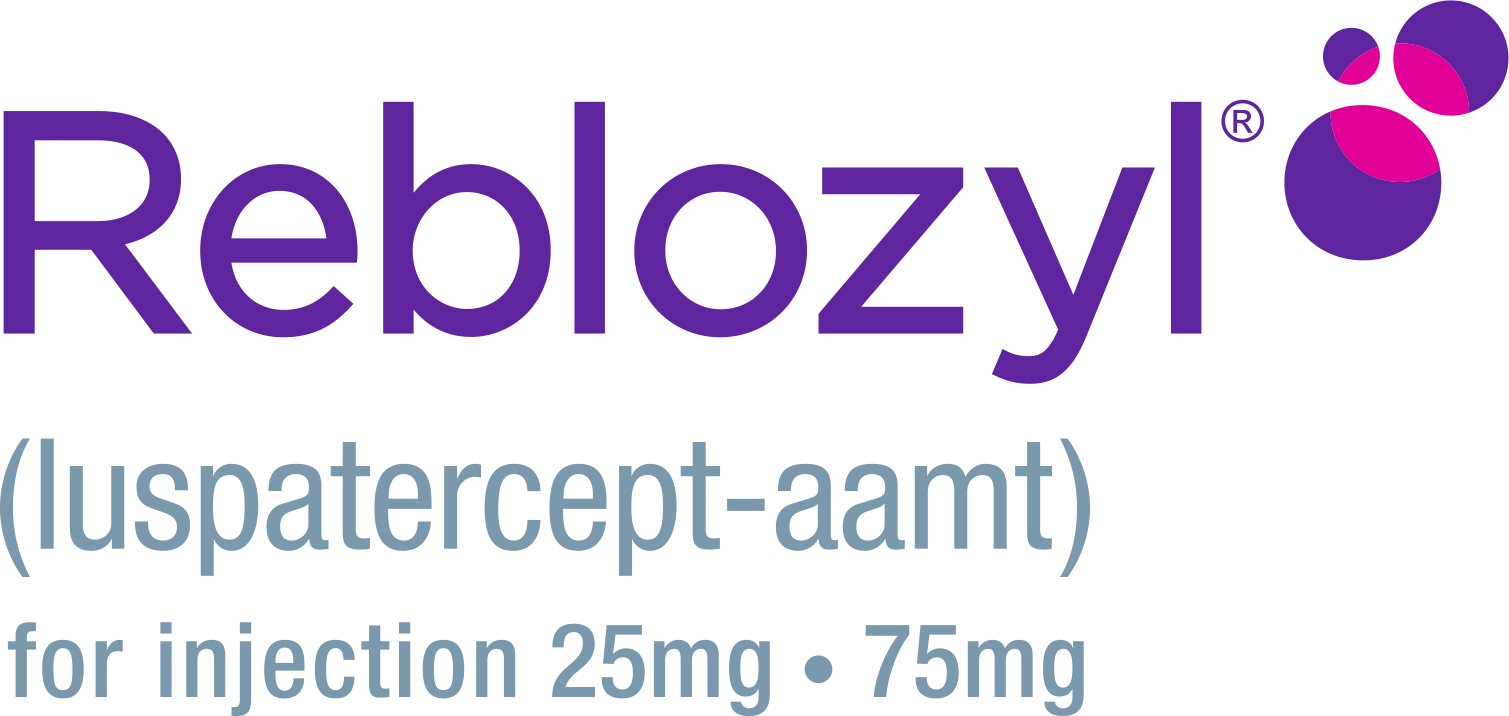Second-line treatment results for REBLOZYL
In a clinical study done to determine the safety and effectiveness of REBLOZYL for people who tried an erythropoiesis stimulating agent (ESA) as their first treatment, REBLOZYL helped lower the need for red blood cell (RBC) transfusions.
The main goal of the study was to stop the need for RBC
transfusions for at least 8 weeks during the first 24 weeks of treatment.

Transfusion independence
With REBLOZYL
NEARLY 3X AS MANY PEOPLE HAD NO RBC TRANSFUSIONS
for at least 8 weeks compared to placebo

The study was designed to assess people who did not respond well to an ESA:

229 PEOPLE
with very low- to intermediate-risk myelodysplastic syndromes with ring sideroblasts (MDS-RS) or myelodysplastic/myeloproliferative neoplasms with ring sideroblasts and thrombocytosis (MDS/MPN-RS-T)

153 PEOPLE
received 1 REBLOZYL injection every 3 weeks; 58 of them achieved the main goal of the study
76 PEOPLE
received 1 placebo injection every 3 weeks; 10 of them achieved the main goal of the study
People in both treatment groups were allowed to receive the best supportive care. This included RBC transfusions as needed.
To be in the study, people needed to receive 2 or more RBC transfusions every 8 weeks. They also needed to:
- Have a poor response to an ESA treatment
- Be unlikely to respond to an ESA, defined as having a blood test that shows high levels (>200 U/L) of a protein called erythropoietin and not having received an ESA previously
- Or not be able to handle the side effects of an ESA treatment
People could not be a part of the study if they had:
- Specific mutations in their DNA (deletion 5q)
- Other blood count disorders
- Received treatment for their underlying MDS
With REBLOZYL, longer periods without transfusions are possible
What are the possible side effects of REBLOZYL?
It’s important to know about the possible side effects of REBLOZYL before beginning treatment. Remember: people may react to medicines differently, and that’s expected.
The possible side effects of REBLOZYL are well studied. In the study, most side effects were considered mild or moderate.
Be sure to talk with your healthcare team about what to expect when starting treatment with REBLOZYL.
What are the serious side effects of REBLOZYL?

Serious side effect
A serious side effect is a side effect that can sometimes become life-threatening and can lead to death. They may happen any time during treatment or even after your treatment has ended. You may experience more than one side effect at the same time.

Blood clots (sometimes called thrombosis or thromboembolism)
Blood clots in the arteries, veins, brain, and lungs have happened in people with beta thalassemia during treatment with REBLOZYL. The risk of blood clots may be higher in people who have had their spleen removed or who take hormone replacement therapy or birth control pills.
Call your healthcare provider or get medical help right away if you have any of these symptoms:
- Chest pain
- Trouble breathing or shortness of breath
- Pain in your leg, with or without swelling
- A cold or pale arm or leg
- Sudden numbness or weakness that is short term or continues to happen over a long period of time, especially on one side of the body
- Severe headache or confusion
- Sudden problems with vision, speech, or balance (such as trouble speaking, difficulty walking, or dizziness)

Hear from someone who has managed MDS-related anemia with REBLOZYL.

Get helpful tools and resources for your MDS-related anemia
Your REBLOZYL Connection™ is an educational program designed to help you understand treatment with REBLOZYL and provide resources so you can take a more active role in your care.

High blood pressure (sometimes called hypertension)
REBLOZYL may cause an increase in your blood pressure. Your healthcare provider will check your blood pressure before you receive your REBLOZYL dose. Your healthcare provider may prescribe you medicine to treat high blood pressure or increase the dose of medicine you already take to treat high blood pressure, if you develop high blood pressure during treatment with REBLOZYL.
What are the most common side effects of REBLOZYL?
The most common side effects are the side effects that were the most frequently reported by patients in the study. You may experience more than one side effect at the same time.
The most common side effects of REBLOZYL include:
- tiredness
- headache
- back, joint, muscle, or bone pain
- joint pain
- dizziness
- nausea
- diarrhea
- cough
- stomach (abdominal) pain
- trouble breathing
- swelling of your hands, legs, or feet
- high blood pressure
- allergic reactions
These are not all of the possible side effects. For more information about side effects, please see the REBLOZYL Patient Information.
Call your doctor for medical advice about side effects. You may report side effects to the FDA at 1-800-FDA-1088.


